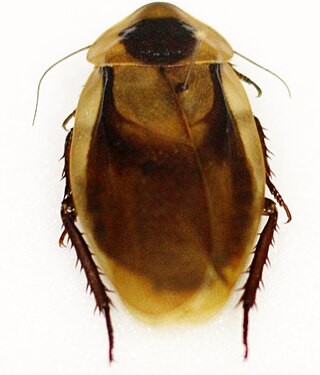
Blaberus discoidalis, commonly known as the discoid cockroach, tropical cockroach, West Indian leaf cockroach, false death's head cockroach, Haitian cockroach, and drummer, is a cockroach native to Central America of the "giant cockroach" family, Blaberidae.

Acanthoplus discoidalis is a species in the Hetrodinae, a subfamily of the katydid family (Tettigoniidae). Like its closest relatives, Acanthoplus discoidalis variously bears common names such as armoured katydid, armoured ground cricket, armoured bush cricket, corn cricket, setotojane and koringkriek. The species is native to parts of Angola, Namibia, Botswana, Zimbabwe and South Africa.

Alecton discoidalis is a species of firefly in the beetle family Lampyridae, commonly known as the Cuban endemic firefly. The larvae of this species are predators on both pulmonate and operculate land snails. Alecton discoidalis is the type species of the genus Alecton.

Prorella discoidalis is a moth in the family Geometridae first described by John Arthur Grossbeck in 1908. It is found in the US states of Arizona, New Mexico and Utah.

Chromacilla discoidalis is a species of beetle in the family Cerambycidae.
Serixia is a genus of longhorn beetles of the subfamily Lamiinae, containing the following species:

Erebia discoidalis, the red-disked alpine, is a member of the subfamily Satyrinae of family Nymphalidae. It is found in North America from eastern Quebec, through northern Ontario, and the northern Prairies to northern British Columbia, the Northwest Territories, Yukon, and Alaska. It reaches just into the northern U.S. between Michigan and Montana, and also occurs in Asia, where it has been recorded from the Chukot Peninsula to the eastern Sayan Mountains and Amur. The habitat consists of large, open, grassy bogs and other areas with acidic soils.
Oberea discoidalis is a species of beetle in the family Cerambycidae. It was described by Karl Jordan in 1894. It is known from the Republic of the Congo, Gabon, Cameroon, the Ivory Coast, and Sierra Leone. It contains the variety Oberea discoidalis var. occidentalis.
Serixia buruensis is a species of beetle in the family Cerambycidae. It was described by Stephan von Breuning in 1958.
Serixia cinereotomentosa is a species of beetle in the family Cerambycidae. It was described by Stephan von Breuning in 1958.
Serixia novaebritanniae is a species of beetle in the family Cerambycidae. It was described by Stephan von Breuning in 1958.
Serixia nilghirica is a species of beetle in the family Cerambycidae. It was described by Stephan von Breuning in 1963.
Serixia longicornis is a species of beetle in the family Cerambycidae. It was described by Francis Polkinghorne Pascoe in 1858.
Serixia prolata is a species of beetle in the family Cerambycidae. It was described by Francis Polkinghorne Pascoe in 1858.
Serixia sedata is a species of beetle in the family Cerambycidae. It was described by Francis Polkinghorne Pascoe in 1862.
Serixia phaeoptera is a species of beetle in the family Cerambycidae. It was described by Per Olof Christopher Aurivillius in 1927.
Serixia atritarsis is a species of beetle in the family Cerambycidae. It was described by Maurice Pic in 1929.
Serixia inconspicua is a species of beetle in the family Cerambycidae. It was described by Gardiner in 1936.
Saprinus discoidalis is a species of clown beetle in the family Histeridae. It is found in North America.
Euphorbia discoidalis, commonly known as summer spurge, is a flowering plant. A dicot, it grows across parts of the southern United States. It reaches about 18 inches (460 mm) in height and has white flowers in the late summer and early fall. It is part of the Euphorbiaceae (spurge) family and the genus Euphorbia.





